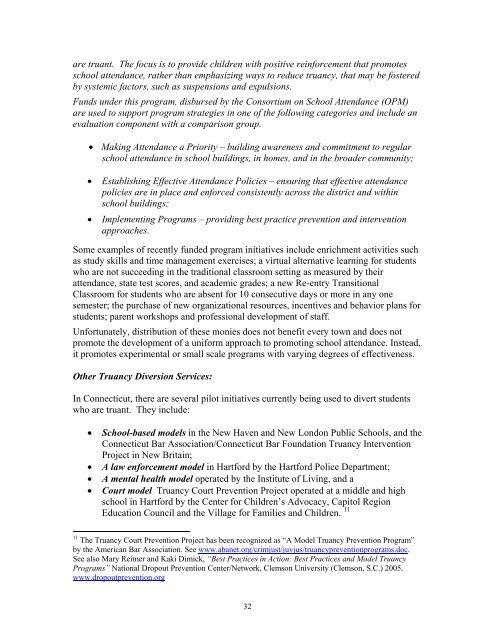FWSN-advisorybd-repo.. - The Connecticut Juvenile Justice Alliance
FWSN-advisorybd-repo.. - The Connecticut Juvenile Justice Alliance
FWSN-advisorybd-repo.. - The Connecticut Juvenile Justice Alliance
Create successful ePaper yourself
Turn your PDF publications into a flip-book with our unique Google optimized e-Paper software.
are truant. <strong>The</strong> focus is to provide children with positive reinforcement that promotes<br />
school attendance, rather than emphasizing ways to reduce truancy, that may be fostered<br />
by systemic factors, such as suspensions and expulsions.<br />
Funds under this program, disbursed by the Consortium on School Attendance (OPM)<br />
are used to support program strategies in one of the following categories and include an<br />
evaluation component with a comparison group.<br />
• Making Attendance a Priority – building awareness and commitment to regular<br />
school attendance in school buildings, in homes, and in the broader community;<br />
• Establishing Effective Attendance Policies – ensuring that effective attendance<br />
policies are in place and enforced consistently across the district and within<br />
school buildings;<br />
• Implementing Programs – providing best practice prevention and intervention<br />
approaches.<br />
Some examples of recently funded program initiatives include enrichment activities such<br />
as study skills and time management exercises; a virtual alternative learning for students<br />
who are not succeeding in the traditional classroom setting as measured by their<br />
attendance, state test scores, and academic grades; a new Re-entry Transitional<br />
Classroom for students who are absent for 10 consecutive days or more in any one<br />
semester; the purchase of new organizational resources, incentives and behavior plans for<br />
students; parent workshops and professional development of staff.<br />
Unfortunately, distribution of these monies does not benefit every town and does not<br />
promote the development of a uniform approach to promoting school attendance. Instead,<br />
it promotes experimental or small scale programs with varying degrees of effectiveness.<br />
Other Truancy Diversion Services:<br />
In <strong>Connecticut</strong>, there are several pilot initiatives currently being used to divert students<br />
who are truant. <strong>The</strong>y include:<br />
• School-based models in the New Haven and New London Public Schools, and the<br />
<strong>Connecticut</strong> Bar Association/<strong>Connecticut</strong> Bar Foundation Truancy Intervention<br />
Project in New Britain;<br />
• A law enforcement model in Hartford by the Hartford Police Department;<br />
• A mental health model operated by the Institute of Living, and a<br />
• Court model Truancy Court Prevention Project operated at a middle and high<br />
school in Hartford by the Center for Children’s Advocacy, Capitol Region<br />
Education Council and the Village for Families and Children. 11<br />
11 <strong>The</strong> Truancy Court Prevention Project has been recognized as “A Model Truancy Prevention Program”<br />
by the American Bar Association. See www.abanet.org/crimjust/juvjus/truancypreventionprograms.doc.<br />
See also Mary Reimer and Kaki Dimick, “Best Practices in Action: Best Practices and Model Truancy<br />
Programs” National Dropout Prevention Center/Network, Clemson University (Clemson, S.C.) 2005.<br />
www.dropoutprevention.org<br />
32
















